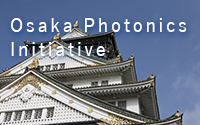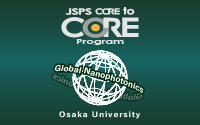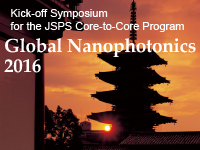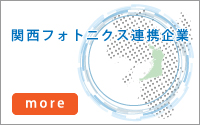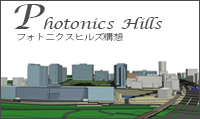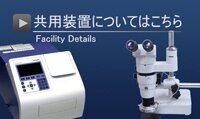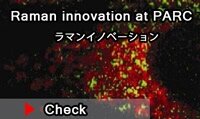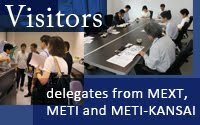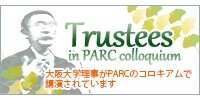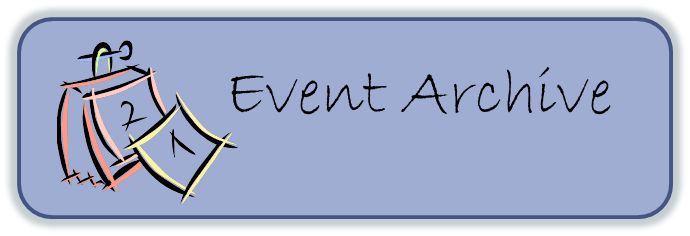|
|
|
Message archive
無題
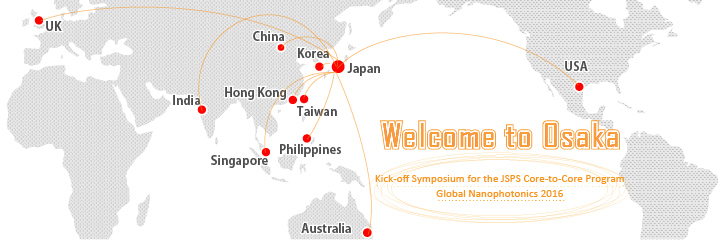
A warm welcome from the Photonics Center, Osaka University to the delegates from the partner institutions of the JSPS Nanophotonics Core-to-Core Program, to join the Symposium "Global Nanophotonics 2016", to be held in Osaka. The delegates are from China, Taiwan, Singapore, Philippines, Korea, India, Australia, USA, Hong Kong as well as Japan. For details, please click here.
|
Asian Engineers / アジアの技術者たち
|
Whether it is academia or business matter, international exchange has great significance for young researchers and technical experts who bear the future. Therefore, if you have any chance to visit foreign countries, please take a chance to challenge for your future. I believe it will be your valuable experience.While I used to work for the former private company, I was in charge of technological development of the optical head for DVD at the company. In summer, 2007 (which was the follwing year of the product commercializing), the company planned to move the overseas base to a subsidiary company in China. Because of my experience I was assigned for overseas posting in Hong Kong and China for 3 years.
After the Plaza Accord (the 1985 agreement of the G5 nations), the value of the yen had soared. Many of Japanese factories were forced to relocate production overseas. Since products such as optical head required manpower for assembly process, due to a wage differential, we established a business framework (domestic technological development and overseas manufacturing). The movie “Ah!the Nomugi toge (1979)” though a little bit old, (that is old Japanese story of the silk industry and the young girls who worked hard as silk spinners in a hot factory.) We had many factories manufacturing domestically, however, most of them were closed and demolished to vacant lots. This is just a changes of the times passing an era. Our next generation will have demands to reconsider about the future state of Japanese company and the manufacturing industry. We need to find an appropriate business field in Japan and hand it over to a new generation. One of the solutions might be to develop the high value-added products with fine processing technology and the most advanced IT technological products which is the fusion of hardware/software.
When I was working at a manufacturing factory in China, thousands of young work women in their teens and twenties lived in a dormitory in the factory site. They manufactured a new product, one after another with three shifts including midnight shift. They had a dance party every weekend, and enjoyed their work and life. It looked hard circumstances for young girls to leave their parental home at an early age. To go home only on long holidays due to long distance and when sending most of their salary to parents. However they were always neatly dressed and enjoyed their work and life at the factory locations. Maybe their salary were enough to them. We were firmly resolved to develop and provide a new product continuously so that those young work women would not lose their job and their employment will be assured.
The team I belonged to consisted of 100 and more of work women and 10 male staff members. The ratio of Chinese and Hong Konger was 4 : 1, the language was all English. (we could not follow in case they speak Chinese or Cantonese language.) Similarly, in Hong Kong and Taiwan, women did the same work among men. All worked through the night. I think Japan has gotten closer to this, but still very few female students study at Mechanical Engineering or Civil Engineering. For translation purpose, those who can speak Japanese are invaluable and helpful to us. However, if we rely on too much on them, we might lose a chance of our own thinking and experiencing. Therefore, “everything in moderation” is the key word, when asking others for help.
In Hong Kong and Shenzhen, I had an opportunity of visiting an exhibition of electronic equipment. The difference from CEATEC, Japan was that many small companies participated in an exhibition with a small booth. Not like a situation where very successful big companies had great power, but all exhibition companies were equally challenging for the market. I felt a great vital power for the future. In Taiwan, many companies started up businesses of semiconductor manufacturing, introducing used equipment. I encountered a situation when the company looking for a purchasing company(in a good way) was negotiating M&A (merger and acquisition ) with a subsidiary company of my overseas posting. With more venture companies and investment companies, I am sure that there must be more chances for the nation to promote M&A (merger and acquisition) compared to Japan.
Generally speaking, Chinese, including the above mentioned workers and staffs, are so friendly to Japanese. I was concerned about rising anti-Japanese sentiment when I heard that Chinese are taught so in a text book in China, however, it is only a matter of politics. Actually Chinese people, being eager to learn techniques and information from Japan, they try to contact with us to establish good relationship.I am sure that if we become friends, we will easily have interesting discussions about current educational status’. Actually I am so sorry that I could not have so many opportunities to communicate with local Chinese people, since I had several Japanese colleagues in the same team. However, I made an opportunity to have dinner with local staffs once a week. Therefore I think I could fully understand how they like Japan and Japanese technology.
I was relocated to overseas, aiming to market development of optical head, however, the situation was difficult due to the subprime mortgage crisis, the economic downturn precipitated by the Lehman Brothers bankruptcy in 2008, and the wave of cruel depression we had ever experienced. In Japan also, we experienced hard times. Some companies terminated contracts with temporary employees, whereas they could not dismiss permanent workers without good reason.Since our team failed in customer development, as company policy, not only factory workers、we were forced to dismiss one in four local staff. Instead of advance notification, the target person was handed one envelop at the final day of the month. I heard that the envelop include a letter of contract termination, a statement of accounts, and job recruitment information. As you know foreign capital companies are very dry (business-like). One of my subordinates (technical man) was forced to receive the envelop without notice. I was intensely sad about his leaving, since he was working so hard with us from the beginning of the business.However, I am so relieved to hear that he overcame his hardship and set up his own trading company which deals with technical related products and doing well. We made vigorous efforts on the optical head business, however, we could not achieve the target earnings and we suspended the business in 2010. The member dissolved, and I returned to Japan and went back to research field. We already decided that we would develop a new theme since our application had already been approved. The optical head was not in much demand but we promised the local staff and members to develop a new product and they would come back.
After that, the theme was suspended due to company’s change of policy, however, the reason of my continuously exerting myself is to realize our promise.Japanese technology, as it used to be, should become the world’s leading technology, competing with Western countries and aiming to develop new industry. When I meet people in different countries on my business I strongly resolved to do so. That is because I inherited the DNA from my ancestors since I was borne in a corner of Asia.
October 3rd, 2016
Dr. Giichi Shibuya
Research Associate
Division of Electrical, Electronic and Information Engineering,
Graduate School of Engineering,
Osaka University
|
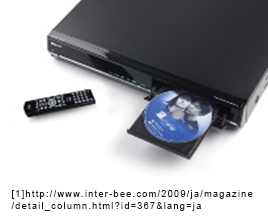 アカデミアであれビジネスであれ、研究者・技術者として将来を担っていく若手の皆様にとって、海外との関連や交流は不可欠です。若手の皆様に置かれましては、これから先、機会があれば、どこの国でも海外への渡航や赴任を進んで志願して頂けると、必ず何物にも代えがたい良い経験ができる筈ですので、是非とも前向きにチャレンジして頂きたいと思います。自分はここへ来る前に在籍した民間企業で、3年間の香港・中国への赴任を経験しました。きっかけは、当時自分が開発を担当していたDVD向け光ヘッド事業の拠点を、中国の子会社に移管することになり、そこでの設計や技術に関する責任を託されたためです。同製品の商品化を達成した翌年の、2007年夏の事でした。 bite-me.net
1985年のプラザ合意以降、円の価値が急騰し、日本国内の工場はすべからく海外へのシフトを余儀なくされ、労働賃金の差の事情から、光ヘッドのように人手による組立工程が基幹となる製品は、開発は国内、製造は海外、が必要な事業体制となってしまいました。映画「ああ野麦峠」は少々古いですが、かつては前の会社でも多くの国内の工場で、同様の風景が見られたものですが、今ではその殆どが閉鎖、解体され、更地になってしまいました。これはもう時代の変化と言うよりありません。我々以降の世代は、新しい日本の企業、特に製造業の在り方が問われていると認識しています。日本国内に適した仕事を見つけ、それを新しい世代に託していかなければなりません。微細加工技術を駆使した付加価値の高い製品や、ハードとソフトが融合した先端のIT技術製品などは、その解の一つかも知れません。
赴任先の中国の製造工場では、数千人もの10~20代の女子工員が敷地内の寮で暮らしており、深夜直も含めた3交代勤務で次々と製品を産出していきます。夜には週ごとにダンスパーティーなどのイベントもあり、皆さんとても元気で、明るい顔で仕事や生活に励んでいます。まだ若いのに親元を離れ、遠いので長期休暇位にしか故郷にも帰れず、稼ぎの多くは仕送りと、一見辛そうに見える境遇でも、綺麗な服も着て、とても楽しそうに生活しています。おそらく給与は、彼女たちにとっては十分なレベルなのでしょう。そんな工員さんたちの仕事がなくなって解雇されてしまう事のなきよう、我々は何とか新製品を提供し続けなければなるまいと思ったものです。
自分の所属していたチームでは、100名超の女子工員に対して、男子のスタッフが10数名。中国人と香港人が4:1位の比率で、言語は全て英語です。(中国語や広東語では、我々が議論に追従できません。)それに女性のスタッフが数名。香港や台湾でもそうでしたが、あちらでは女性が普通に男性に混ざって、同じ仕事をしていますし、ホテルの窓口など、徹夜の仕事も均等です。日本も最近はこれに近くなったかもしれませんが、機械工学科や土木工学科などに在籍する女性は、まだ希少なのではないでしょうか?通訳のために、日本語のできる人が重宝されており、我々も随分と助けられましたが、頼りすぎは、自ら悩んだり経験するチャンスを逃しますので、助けを乞うのは程々が良いと思います。
香港や深圳では、電子機器の展示会に行く機会もありました。日本のCEATECとの違いは、小さいブースを構えた会社が多数集まっていること。勝ち組のような大会社のみが幅を利かせている状況ではなく、全ての展示会社が同様に市場にチャレンジしているように見えて、将来への活力を感じました。ちなみに台湾でも、中古の設備を日本から導入して、半導体製造会社を始めるといった企業が一頃は多くあり、ある会社は(良い意味での)買収して貰える先を探していて、前述の赴任先の子会社にM&Aをアピールしていた場面に立ち会った事もあります。ベンチャー起業も投資会社も多く、国家としてそれを推奨する機運が日本よりも高いことは確かだと思います。
前述の工員さんやスタッフも含め、中国人は総じて我々日本人に対し、友好的です。反日感情が高いとか、現地の教科書でそう教えているとか、しばしば日本国内では指摘されており若干心配もしましたが、自ら体験する限り、それらは政治の話だけのようです。また、皆さん競って、日本の技術や情報を盗もうと、進んで接触してきます。そんな彼らと仲良くなれば、現地の教育の実態など、必ず興味深く面白い話が沢山できると思います。かく言う自分は、日本人の同僚がチーム内に数名いた事もあり、あまり交流の機会を利用することができませんでした。今思えば若干後悔の念もありますが、それでも週に1回は、相談して現地のスタッフと晩の会食をするようにしていましたから、彼らの日本や日本の技術を好きな気持ちも十分に理解できたのだと思います。
さて、光ヘッドの海外への市場展開を求めて赴任したにもかかわらず、サブプライムローン危機、リーマンショックと、非情にも空前絶後の不況の波が押し寄せ、日本でも多くの企業が、容易に解雇できない正社員の代わりに、派遣社員はことごとく契約を打ち切られるという、厳しい事態となってしまいました。我々のチームも、どうにも顧客の開拓が立ち行かず、会社全体の方針で、工員さんのみでなく、現地のスタッフも4人に一人の割合で解雇せざるを得なくなりました。その方法は、事前通達は一切なく、該当者は月の最終日に、一組の封筒を渡されるというものでした。内容物は、契約打切りの通達書と、各種の清算書、更には今後の転職案内なども同封されていたと聞きます。外国の会社は、この辺りはとてもドライです。自分の部下だった技術者の一人も、予告なしで封筒を受け取らされました。正直彼には、業務上の短所がないことはありませんでしたが、同事業の立ち上げの時から来日してOJTで頑張ってくれていたメンバーだけに、より一層悲痛な思いを感じました。しかしその後の彼は、逆境に負けず、技術関連の製品を扱う商社を自ら起業して、頑張ってくれているようです。その後の光ヘッド事業は、日本の規格を踏襲した中国の独自規格[1]をリリースするまで健闘しましたが、残念ながら計画していた収益に届かず、2010年に事業は中止、メンバーは解散し、自分は帰国して研究部門に戻ることとなりました。新しいテーマの開発を行うことは、この時点では、既に申請し審査をパスして、決まっていました。光ヘッドは今一つ売れませんでしたが、必ず新しい製品を開発して、また戻ってくるからと、現地のスタッフやメンバーと約束してきました。
その後、会社の方針の変化で、そのテーマも中止とされてしまいましたが、現在の自分は、この時の約束を実現するために必死で奮闘しているようなものです。日本の技術は、かつてそうだったように、これからも欧米の諸国に負けず、世界をリードして、新しい産業を開いていかなければならない。海外出張や勤務で他国の方々と接触していると、そのような思いを特に強く抱いてしまうのは、やはり自分がアジアの片隅の一国で生を受けた時に、先人たちより受け継いだDNAの影響なのだろうと思います。
2016年10月3日
澁谷 義一 博士研究員
工学研究科
電気電子情報工学専攻
|
Self-Introduction / ごあいさつ
|
My name is Kazuto Yamauchi and I am a new member at the Photonics Center. “Light” for me is X-rays and, therefore, I would like to describe some of the developments in X-ray optics while telling you a little about myself.
X-rays were discovered in 1895 by Wilhelm Röntgen. In 1912, less than twenty years later, Max von Laue discovered the diffraction of X-rays by zinc sulfide crystals, and the following year William H. and William L. Bragg, father and son, presented Bragg’s law. These brilliant achievements gave us light that enabled humans to see atoms, the greatest beneficiary of which is the field of crystal structure analysis. A hundred years later, the U.N. General Assembly proclaimed 2014 to be the International Year of Crystallography, showing just how much X-rays have contributed to crystallography. In the meantime, optics and crystallography have grown immensely, through mutual stimulation, and have dramatically improved the performance of light sources. Higher throughput has been the greatest need for crystal structure analysis, and particularly for the structural analysis of proteins. X-rays in the form of synchrotron radiation sources have shown rapid advancements in brilliance since around 1990. As a result, X-rays acquired the byproduct spatial coherence, which had not been particularly needed for crystal structure analysis, and a new discipline called coherent X-ray optics was born at synchrotron radiation facilities such as SPring-8. While it is somewhat misleading to say, their function as a tool for viewing matter may have brought X-rays back to the forefront of science.
I was a newcomer to the field at this time, working to develop mirrors based on precision machining and metrology for preserving coherence in the light source. We became the first in the world to successfully achieve diffraction-limited focusing and imaging. We also developed a technique for measuring wavefronts based on wave optics and an adaptive optical system for correcting deformations in the wavefronts, and achieved X-ray scanning microscopy with a sub-10 nm spatial resolution and coherent diffraction microscopy approaching a spatial resolution of 1 nm. I take great pride in having contributed in some small way to the advancement of X-ray microscopy based on synchrotron radiation.
Now, synchrotron X-rays have been successfully developed into an X-ray free-electron laser. X-ray FEL facilities are currently installed at two locations: the Stanford Linear Accelerator Center in America and the Riken Harima Branch in Japan. These ultrashort pulse lasers produce wavelengths covering the hard X-ray region, with a pulse duration of femtoseconds. The peak intensity of the beam approaches 10 billion times that of SPring-8. It is a dream light source that is in the process of developing entirely new X-ray sciences. The X-ray mirrors fabricated with our method are called Osaka Mirrors and have been installed at both facilities in the U.S. and Japan. A venture company financed by Osaka University Venture Capital (OUVC) ships the mirrors worldwide, and advanced development of the mirrors is now undertaken by postdoctoral researchers.
Recently we succeeded in observing two-photon absorption with Japan’s X-ray FEL SACLA, using a beam focused down to 50 nm. K emissions were observed when exciting germanium with 5.6-keV X-rays. The intensity of the K fluorescence was essentially proportional to the square of the exciting X-ray intensity. Energy of 11.1 keV was necessary for exciting the Ge K-shell, and there was no intermediate state for two-stage excitation. In fact, the two 5.6 keV photons were absorbed simultaneously with no intermediate state, transferring 11.1 keV of energy to the K-shell electron. The second photon acts within a few hundred zeptoseconds from the first, before the ripples of the first photon have even subsided. This is the first observation of its kind in the X-ray region.
I have continued research on coherent X-ray optics and have been involved in the development of various X-ray devices. However, everything I have done to this point academically has been in optics rather than photonics. If it were not for X-ray FEL making nonlinear optics experiments possible in the X-ray region, I would have been hesitant to join the Photonics Center. This is an exciting area with boundless potential.
As a new member, I hope to contribute to research in photonics in the X-ray region, as well as in surface generation and the like for photonic materials using my specialty of precision machining. But I will cut my self-introduction off here before this gets too lengthy.
August 22, 2016
Kazuto Yamauchi, Professor
Division of Precision Science and Technology and Applied Physics
Graduate School of Engineering
Osaka University
|
フォトニクスセンターのメンバーに新しく加わることになった山内です。私にとっての「光」はX線ですので、X線光学の発展に触れつつ、自己紹介をさせていただこうと思います。X線はレントゲンにより1895年に発見され、その後20年も経たぬ1912年にラウエが硫化亜鉛結晶からの回折現象を見出し、翌1913年にはブラッグ父子がブラッグの法則を発表しました。これらの偉業によって、人類は原子を見る光を手に入れることになります。そして、最もこの恩恵に与ったのが結晶構造解析の分野です。このときから100年目となる2014年を国連総会が国際結晶年に指定したことからも、X線が結晶学に如何に貢献したのかが分かります。この間、X線光学と結晶学は、お互いを強く刺激し合いながら大いに発展し、光源の性能も飛躍的に向上しました。結晶構造解析のハイスループット化は、特にタンパク質の構造解析では至上の要求であり、1990年頃から、放射光X線光源の高輝度化が急速に進むことになります。その結果、X線は、結晶構造解析にはあまり必要でなかった空間コヒーレンスを副産物として獲得することになり、新たな学問領域である「コヒーレントX線光学」がSPring-8などの放射光施設を舞台に誕生しました。若干の語弊がありますが、物質を見るツールとしての存在から、X線そのものが再び最先端のサイエンスの対象になったと言えます。
この頃に、私は新参者として、この分野に入りました。精密加工・計測学をベースに、光源のコヒーレンスを保存するミラーの開発に挑戦し、回折限界の条件での集光や結像に世界で初めて成功しています。また、波動光学にもとづく波面の計測法や、これを補正する補償光学システムなどを開発し、分解能sub-10nmの走査型X線顕微鏡や分解能1nmに迫るコヒーレント回折顕微鏡などを実現しました。放射光ベースのX線顕微法の高度化に多少なりとも貢献できたものと自負しております。
さて、放射光X線はX線自由電子レーザーへと発展を遂げています。現在、米国のスタンフォード研究所と日本の理化学研究所播磨研究所の2ヶ所にこの施設があります。発振波長は硬X線領域をカバーする時間幅フェムト秒レベルの極短パルスレーザーです。ピーク強度はSPring-8の100億倍に迫ります。まさに、夢の光源であり、全く新しいX線科学が展開されつつあります。我々の方法で作製したX線ミラーは“OSAKA-Mirror”と呼ばれ、米国と日本の両方の施設にインストールされています。OSAKA-Mirrorは、大阪大学ベンチャーキャピタル(OUVC)が出資しているベンチャー企業から世界中に送り出されており、博士後期課程修了の学生が最先端の開発を担っています。
最近、日本のX線自由電子レーザーであるSACLAの50nm集光ビームを使って、2光子吸収の観察に成功しました。5.6keVのX線でゲルマニウムのKα線が観察されたのです。Kα線の強度は基本的に励起X線強度の2乗に比例していました。GeのK殻の励起には11.1keVのエネルギーが必要であり、2段階励起をするための中間状態はありません。まさに、2つの5.6keVの光子が中間状態を介さず同時に吸収され、11.1keVのエネルギーをK殻電子に与えたことになります。1つ目の光子による細波が消えない数100ゼプト秒の時間内に2つ目の光子が作用しています。X線領域では初めての観察になりました。
コヒーレントX線光学の研究を続け、色々なX線デバイスの開発に携わることができました。ただし、やってきたことは学術的にはオプティクス(光学)そのものであり、フォトニクスではありません。これだけですと、フォトニクスセンターのメンバーに加わることは憚られたのですが、X線自由電子レーザーは、X線領域での非線形光学実験を可能にしました。奥が深く、エキサイティングです。
新メンバーとして、X線領域でのフォトニクスや、元々の専門であった精密加工によるフォトニクス材料の表面創成などで貢献できればと考えています。長々と書きましたが、まずは、自己紹介まで。
2016年8月22日
山内 和人 教授
大阪大学大学院工学研究科
精密科学・応用物理学専攻
|
The Advancement of Science and the Cost to Society / 科学の発展と社会のコスト
|
The other day, I was astonished to read the top news headline on Yahoo! Japan: “A Drug that Will Destroy the Country”. This headline was linked to an article run by the S Newspaper. Thinking that the possibility of just one drug alone causing the downfall of an entire country was extraordinary, I read the article with curiosity. The drug discussed in the article was not a narcotic or stimulant, but rather an anti-cancer drug called O that in recent years has been newly introduced to the Japanese pharmaceutical market by Company O. O is a revolutionary drug with the unprecedented anti-cancer action mechanism of killing cancer by enhancing immune system functioning. Previously existing anti-cancer drugs have targeted cancer cells directly, but they can also attack healthy cells and have many side-effects. In contrast, O acts on immune functioning and has few side-effects and could potentially be effective against a range of cancers; thus, it is generating tremendous expectations as a cancer therapy. A point that we researchers in academia should focus on in particular is that the development of O is based on the research of Prof. Dr. Tasuku Honjo of Kyoto University and is a university-developed pharmaceutical. How can such a wonderful drug “destroy” a country? The answer is that the dug is incredibly expensive. Although the cost apparently depends on the number of times it is administered, O costs 35 million yen per patient per year. The article described how this fact became an issue in a Ministry of Finance meeting. If one half of the more than 100,000 non-small cell lung cancer patients who are eligible for treatment with O (50,000) were treated with O, the annual cost would be 1.75 trillion yen, and even with the government partially covering that amount, the cost could run into several hundreds of billions of yen. At this Ministry of Finance meeting, there was a debate over whether or not this cost burden had the potential to bankrupt national finances, and it was apparently proposed at the time that restrictions be placed on use of the drug for patients aged 75 years or older in order to avoid national bankruptcy. While it is impossible to ignore the financial reality, surely emotionally this is a truly pitiful story. Although it is not my intention to criticize debates such as this, what especially shocked me when I read the article was the problem of the cost involved when something new is developed through academic research. Unlike ordinary industrial goods, it is possible to commercialize and reap profits for pharmaceuticals—even when the cost is enormously high—because drug development not only received government assistance but is also an issue that involves human lives. Consequently, the tendency towards ignoring the extent of costs is likely to strengthen. This situation is not limited to O, and with the advancement of research, the number of diseases that will be able to be cured will increase more and more, while at the same time, the financial burden on society will also continue to steadily increase. This poses an unspeakable dilemma in which the lives of many people are saved but society as a whole comes under financial constraints. As scientists, it is only natural that we should think about how to create things that are effective yet inexpensive. However, when speaking specifically about pharmaceuticals, this could be an especially high hurdle to overcome. Thinking carefully about these issues, I remembered something—I personally have had the experience of developing a product jointly with a company up to a point just before commercialization only to have the project ultimately rejected because the production costs were too high. Unlike companies, in academia it is often the case that research and development is undertaken without taking into account the eventual costs from the very beginning. This is because in academia, what come first are establishing the principles of the developed drug (invention) and publishing academic papers. In particular, research that focuses only on lowering production costs does not produce academic papers with great impact in many cases. However, it goes without saying that carrying out research that can be practically applied to society should truly be recognized and praised. Reading this article reminded me, partly as self-admonition, to keep this point in mind as I carry out my research activities.
May 13th, 2016
Yuichiro Hori, Associate Professor
Division of Advanced Science and Biotechnology Graduate School of Engineering, Osaka University |
先日、Yahooのトップニュースをみて驚いた。「1剤が国を滅ぼす」これは、原典がS新聞の記事の見出しだ。たった一つの薬が国の破綻につながるというとは、尋常ならざることだと思い、その中身を読んでみた。そこに書いてあった薬は、麻薬や覚せい剤の類ではなく、近年、O薬品から新たに販売された抗癌剤Oという薬であった。Oは、免疫機能を活性化させ癌を死滅させるこれまでにない抗癌機序を持つ画期的なものだ。これまでの抗癌剤は、癌細胞そのものを標的とする一方、正常細胞に対しても作用し副作用が多いことが問題であった。これに対し、免疫機能に作用するOは、副作用が少ないことや様々な癌に効く可能性があることから、癌治療における大きな期待を集めている。我々アカデミアの研究者が特に注目すべき点は、Oの開発は、京都大の本庶先生の研究が元になっており、大学発の医薬品であることだ。このような素晴らしい医薬品がなぜ、国を滅ぼすのか?その答えは、あまりにも高価であるということだ。使用回数にもよるようだが、なんと、患者一人当たり1年間で3500万円もかかるとのことだ。このことが、財務省の会議室で問題となったと記事は伝えている。Oの適用対象である非小細胞肺がんの患者10万人強のうち、半数の5万人がOを使用すると薬代に年間1兆7500万円もかかり、国費でその一部をまかなうだけでも数千億円規模になる可能性がある。その会議では、この負担により、国家財政を破綻させる可能性があることが議論となったとのことだ。このとき、国家財政の破たんを免れるため、75歳以上は使用制限をすることなどが提案されたそうだ。財政の現実を無視することはできないものの、感情的には何とも切ない話ではないだろうか。もっとも、このような議論を批判するつもりはないが、特に、この記事を読んではっとさせられたのは、アカデミア研究により新しいものを開発した時のコストの問題である。通常の工業製品と違い、医薬品となると国の補助があると共に命に関わる問題であるから非常に高価でも製品化されて利益を出すことができる。その結果、コスト度外視の傾向はより強まるだろう。このことは、Oだけに限らず、研究の先端化により治る病気はこれから益々多くなるだろうが、同時に社会が負担するコストは増加の一途だろう。多くの人の命が救われる一方、社会全体として逼迫する状況になるのは何ともいえないジレンマである。科学者として考えるべきことは、低コストで効果のあるものを生み出そうとするのは当然であろう。しかしながら、こと医薬品に限って言えば、それは極めてハードルの高いことなのかもしれない。このようなことをつらつらと考えていて思い出したことがあった。それは、以前に、企業との共同研究で製品化直前まで行き、その物品の生産コストが高価すぎてご破算になった経験が自らにあることだ。企業とは異なり、アカデミアでは、最終的なコストのことを最初から考えずに研究開発を行うことが多くあるだろう。まずは、開発したものの原理の確立があり学術論文を出すことが最初に来るからだ。特に生産コストを下げるだけの研究は、論文として大きなインパクトを持ったものにならないことも多い。しかしながら、社会に実際に繋がっていく研究を行うことこそが本当に評価されるべきなのは言うまでもない。このことは自戒を含めて念頭に置きつつ研究を進めて行きたいと記事を読んで改めて思った今日この頃である。
2016年5月13日
堀 雄一郎 准教授
大阪大学大学院工学研究科 生命先端工学専攻 |
Research on Magnetic Computers / 磁性コンピュータの研究
|
Most functions in the computers that we use in our daily lives are implemented with semiconductor devices. If we could replace these semiconductor devices with magnetic devices, we could build a computer that is highly resistant to radiation and that uses very little energy, requiring no power to preserve information. While such a computer may or may not be feasible, our lab was presented with the opportunity to conduct research on magnetic computers. I believe it was in the year 2001. A former professor had just returned from a business trip overseas and informed us that they were studying the use of magnets in logical operations there. However, magnetic bodies was not this professor’s specialty, and it was apparent that he understood little of the research and could offer no further information than the two keywords “magnets” and “operations.” There were a few ideas at that time, albeit few, for using tiny magnetic bodies and magnetic wires to perform computations. However, I had drawn no connections between the two since these devices had a long way to go before being useful for calculations. At some point, it struck me that we may be able to perform computations with small magnets if we packed several of them close together. The outcome may have been different had we first studied the existing research. Two magnets repel each other when their north poles or south poles are brought close together because the system is in a high-energy state due to the magnetic fields produced by both magnets. Consequently, the system attempts to lower this energy state by moving the magnets away from each other. If the north pole of one magnet is brought close to the south pole of the other, the energy of the system drops as the two poles near each other, causing the magnets to stick together. When a tiny magnetic body is formed on a silicon substrate, on the other hand, the system lowers energy by reversing the orientation of the magnet’s north and south poles, i.e., the direction of magnetization, since the magnet itself cannot move. This means that a certain action will lead to a certain result, which could be construed as a logical operation. Initially we decided to apply for a patent on this concept in March 2002 (unexamined patent application No. 2003-280892). At that time, we had focused only on the concept of using magnetic bodies for logical operations and, looking back, the shape and system of these devices are now considerably different. We strayed from this research for a while after that, but in 2003 we had a visiting postdoctoral fellow from Bangladesh, named Anis, explore some structures for devices through micro magnetic simulations. Anis specialized in computer science and had no specific knowledge of magnetic bodies. Perhaps for the very reason of not being constrained by common knowledge of magnetic bodies, he referenced papers on logical operations using electric fields and conducted simulations on magnetic elements with similar structures. It may have been just good fortune, but after about a half year he discovered a system for implementing logical operations with magnetic elements. When four magnetic bodies are arranged in close proximity to each other and data is inputted into three of the bodies, the direction of magnetization in the remaining magnetic body indicates the result of the operation and, thus, the output of the system. This configuration was shown to perform logical NAND and NOR operations (S.A. Haque, M. Yamamoto, R. Nakatani, and Y. Endo, J. Magn.& Magn. Mater., 282, 380-384 [2004]). These findings have led to the current research, which has progressed from simple logical operations to elements that transmit data to each other and elements that divert data. Thus, there is promise for building a magnetic computer by connecting these elements together (H. Nomura, M. Yamamoto and R. Nakatani, Appl. Phys. Exp., 4, 013004 [2001]). The magnetic logic gates mentioned above possess an extremely strong resistance to radiation and use no power to preserve data, which should allow them to operate under the extreme conditions in space and around nuclear reactors, for example, environments for which semiconductor devices are unsuitable. So what is the point? Looking further into the future, the environment on earth will one day become inhabitable for humans. Like in the plot of a science fiction story, humans may have to resettle in another planetary system. However, the effects of radiation in space described above are actually much stronger than people think. It is unlikely that living organisms would be able to tolerate it. It has been suggested that zygotes could survive in such an environment, perhaps shielded by water. At birth, humans have a very immature form and require a lengthy development period. Conversely, this lengthy development period is necessary for the growth of human intelligence. Even if the zygotes were incubated in space, they must be educated in order to be raised as intelligent beings. Some people have envisioned robots to fill the role of educators. Naturally, the robots could not be dependent on semiconductor devices since semiconductors are vulnerable to cosmic rays. The robots would need to possess a brain that functions using magnetic logic gates. While this may appear to be an extreme fantasy—we would need to launch numerous spacecraft controlled by magnetic computers with the hope that one lucky spacecraft would discover a star system in which humankind could survive, and would have to incubate cryopreserved zygotes that would then be educated by robots once they become young humans—this may be the only solution for the survival of humankind. Of course all of this ignores the significance of going to these length to sustain the existence of humankind. April 12, 2016 |
皆さんが毎日のように使っているコンピュータの機能の多くは半導体デバイスによって行われています。これを磁性デバイスで置き換えると、放射線に極めて強く、情報保持に電力が不要で、消費エネルギーの低いコンピュータを作ることができます。実現できるかどうかわかりませんが、私たちの研究室では、あるきっかけで、この研究を始めました。
おそらく、2001年だと思います。前任の教授が海外出張から帰り、「磁石で演算する研究がある。」と言うのです。しかし、その教授は磁性体は専門ではないので理解しなかったらしく、「磁石」、「演算」という2つのキーワードのみで、それ以外の情報がありません。当時、微小磁性体や磁性ワイヤを用いた演算という概念は少ないですが存在していました。しかし、演算ということには、まだ程遠い状態でしたから、それらについては連想しませんでした。思いついたのは、複数の微小磁性体を近接して作製すれば演算になりそうだなということです。過去のことを先に調べ始めれば、違った結果になったかもしれません。 2個の磁石はN極とN極、あるいは、S極とS極を近接すると、それらの磁石は反発します。それはお互いの作る磁場により系のエネルギーが高くなるので、2個の磁石をなるべく遠ざけて、系のエネルギーを低下させようとするからです。N極とS極を近づければ、近づいた方がエネルギーが低下しますので、N極とS極はくっつきます。Si基板上に微小磁性体を形成すると、磁石は動けませんから、磁石のN極とS極の向き、すなわち、磁化の向きが反転し、エネルギーを低下させます。これは、あることを行うと、ある結果が生じるわけですから、考えようによっては演算です。 とりあえず、この概念を2002年3月に特許として出願しました[特開2003-280892]。今から考えると、概念だけ考えたわけですから、形状、システムは今とはかなり違います。しばらく、その研究は放置していましたが、2003年にAnisというバングラデシュからきたポスドクにマイクロマグネティクス・シミュレーションを使って、素子としての構造を模索してもらうことにしました。彼は、コンピュータサイエンスが専門で、磁性体は非専門です。磁性体の常識にはとらわれませんから、電場によって演算する論文を見つけてきて、似たような構成の磁性体素子についてシミュレーションを行いました。幸運だったのかもしれませんが、半年くらいで演算する系が見つかります。4個の磁性体を近接し、情報を3個の磁性体に入れておくと、残りの1個の磁性体の磁化の向きが演算結果となり出力されそうです。その演算はNANDおよびNORの論理演算でした[S. A. Haque, M. Yamamoto, R. Nakatani and Y. Endo, J. Magn. & Magn. Mater., 282, 380-384 (2004)]。 現在では、そこから始まった研究は、論理演算だけではなく、情報を素子間で伝搬したり、情報を分岐する素子にも発展しています。これらを接続すればコンピュータができあがりそうです[H. Nomura and R. Nakatani, Appl. Phys. Exp., 4, 013004 (2011)]。 上述の磁性演算素子は、放射線に極めて強い耐性を持ち、また、情報の保持に電力を使いませんから、宇宙空間、原子炉の近傍などの極限環境でも動作するはずです。これは、半導体素子には不得意な環境です。何を言い出すかと言われそうですが、もっと将来のことを考えますと、いずれ地球は人類の住める環境ではなくなり、SFなどでは、他の惑星系への移住が題材になっています。しかし、現実には上記のような宇宙放射線の影響は皆さんが考えるよりずっと強く、生体はそれには耐えられないと思います。受精卵くらいなら可能かとも言われています。受精卵を水でシールドしようと言うのです。 人間は、極めて幼形で出産され、それからの教育期間が長く必要です。逆に、その教育期間が長いことが、人類の持つ知性の発達に重要となっています。上記の受精卵は、孵化させても、教育しなければ知性を持つ人間には育ちません。その教育はロボットが行うものと想像されています。そのロボットは半導体素子には頼れません。半導体は宇宙線に弱いのです。従って、磁性論理演算素子により動く頭脳を持つロボットがキーとなります。夢物語×夢物語みたいな話ですが、磁性コンピュータ制御された宇宙船を数多く出発させ、幸運な一隻が人類生存可能な星系を見つけ、冷凍した受精卵を孵化させ、幼い人間をロボットが教育する。これが人類存続への唯一の回答かもしれません。そこまでして、人類を存続させる意味については考えないことにします。 2016年4月12日 |
"Thoughts on "The 5th Science and Technology Basic Plan"" / 『科学技術基本計画と「わたし」』
|
April 2016 marks the beginning of the fifth installment of the Science and Technology Basic Plan — a government-established, systematic and coherent basic plan for executing long-term science and technology policy that was developed in the Science and Technology Basic Act in 1995. I am embarrassed to say that I did not know of the plan until I heard it in a seminar about a month ago, but the new plan—which is based on the results and challenges of the 20-year period for Plans 1 through 4 and reflects the current global, social, and economic situation— will unquestionably impact the entire breadth of science and technology, both in academia and industry. The Basic Plan states Japan’s Vision for the future to become a country that: shows sustainable growth, both as a nation and in local communities ; provides a safe, affluent and high quality of life for citizens; can contribute to solving global problems and promoting global development; and consistently creates innovation. To achieve the vision, the plan promotes: value creation initiatives for future industry creation and social transformation; responses to economic and social problems; investment in basic research ; and development of human resources, intellectual property, and a desirable funding cycle. Universities are called to play a crucial role in increasing the level of basic research, with challenging targets being established, including a 10% share in the top 10% of most cited papers, a 50% increase in joint research funds from companies, and a 50% increase in the number of licensed patents, while achieving growth in the number of young faculty, growth in the number of female faculty, and growth in the total volume of published papers. Although I always nod with appreciation at such talk, in the back of my mind I also wonder, “Specifically, what do we have to do?” Having heard the Basic Plan, do I, for example, need to change my approach in the research lab or the way I interact with students? It is not like I am procrastinating at the moment (at least I believe so), but in the case I need to change something, then what and how? I do not think this is a problem related to just science and technology-related policies, but because most national policies are formulated with a long-term perspective, the plans are just overly grand and do not seem at all related to myself. I wish that the plan was detailed enough to include specific suggestions targeted at people working at the field level (e.g., young university faculty), so that the people affected by the policy can better see the problem as their own. There is no way for me to know what the people who developed the Basic Plan were ultimately expecting, but if there was something I could do toward achieving the goals set in the Basic Plan, it would be to make a small change to my research mindset. Regarding this, there is one phrase from a seminar I attended in 2014 that left a strong impression: “Do what is important, not what is interesting.” Stated by a science and technology investor, the words resonated in a very refreshing way. Researchers frequently pursue research that piques their interest, and this attitude is accepted without question, especially at universities. However, the above phrase is telling us that if we desire to truly contribute to society, we need to take on critical problems faced by the world and not problems that only we find interesting. Although it is easy to forget in the face of intense research competition, the fundamental purpose of engineering studies, after all, is to resolve problems facing society. It is always important to come back to the simple perspective of “doing research that benefits people”. I must admit though, that my current research mindset is not exactly aligned with the words above. This comes from my conviction that a problem is important because it is difficult to solve. Usually, it takes more than a good idea – a breakthrough – to solve it. And where do breakthroughs come from? From interesting basic research. So, I think the most desirable approach is to engage in both kinds of research activities, with a slightly higher priority in solving the important problems: i.e., “do what is important, and what is interesting”. I think universities are a great workplace in that the faculty can direct his/her research at his/her own discretion (in most cases). With an organization like PARC, researchers in academia can exchange information and ideas with researchers in industry on important problems and cutting-edge technologies. For a researcher, what more could you ask for, if research, driven by your own intellectual interest, could solve one of world’s most important problems?
March 14th, 2016
Hiroyuki Yoshida
Assisstant Professor
Division of Electrical, Electronic and Information Engineering,
Graduate School of Engineering,
Osaka University
|
皆さんは「科学技術基本計画」について聞いたことがありますでしょうか?私は先日参加したセミナーで初めて知りましたが、政府が長期的視野に立った、体系的かつ一貫した科学技術政策を実行するための基本計画のことで、平成7年に「科学技術基本法」が策定されてから5期目の基本計画が2016年度から始まります。当然、新しい基本計画は1期-4期までの20年間で得られた成果や課題、また世界・社会・経済情勢を反映して立案されていますので、科学技術に係るすべてのものに大きく影響を与えるものとして、新聞などにも取り上げられています。 基本計画を全て理解したわけではありませんが、計画では「目指すべき国の姿」として「持続的な成長と地域社会の自律的な発展」、「国及び国民の安全・安心の確保と豊かで質の高い生活の実現 」、「地球規模課題への対応と世界の発展への貢献 」と「知の資産の持続的創出 」を掲げ、その実現のために「未来の産業創造と社会変革に向けた新たな価値創出の取組 」、「経済・社会的課題への対応 」、「基盤的な力の強化」、そして「人材、知、資金の好循環システムの構築」を推進することを述べています。大学が特に関係するのは「基盤的な力の強化」で、若手教員、女性教員の拡充の他、総論文数を増やしつつ、総論文数に占める被引用回数トップ10%の論文の割合が10%となることを目指す、企業からの共同研究受入額の50%増加を目指す、特許実施許諾件数の50%増加を目指すなど、挑戦的な目標設定がなされています。 このような話をいつも「なるほど」と思って聞くのですが、その一方で、具体的に何をすればよいの?と思うことがあります。今も(少なくとも自分なりには)怠けているわけではありませんので、この計画を聞いて、研究室での振舞いや毎日接する学生の指導方法を一体、どのように変えればよいのか、イメージがわきません。この問題に限らなくても、国の政策は極めて長期的な視点に立って策定されていることが殆どと思いますが、計画があまりに壮大過ぎて、自分とは全く関係ないように思えることがあります。現場レベルで政策に係わる人(例えば若手大学教員)が具体的に取り組めることまで合わせて提案されていれば、より身近な問題として認識できそうなのになぁ、と思うことがあります。 基本計画を策定した方が何を想定されているかは結局、分からないのですが、科学技術基本計画の実現に向けて自分が何かできるとすれば、研究に対するマインドセットを少し変えることかな、と考えています。これについては2014年に受講した研修で聞いた、次の言葉が強く印象に残っています。"Do what is important, not what is interesting"-この言葉は科学技術に投資する立場の方から聞いたのですが、自分には極めて新鮮にヒットしました。研究者は自分の興味に突き動かされて研究を進める場合が多いと思いますし、特に大学においてはそれが正しい姿のように思えます。ただ、世の中に本当に貢献したいのであれば、自分が興味のある問題にでなく、世の中が抱える重要な問題に挑みなさい、と上の言葉は言っています。近年の加熱する研究競争で忘れがちではありますが、工学が本来、社会が抱える問題を解決することを目的とした学問であることを考えると、人の役に立つことを研究する、というシンプルな視点は非常に重要だな、と思います。 と、このようなことを書きながら、今の私の研究に対するマインドセットは実は、上の言葉そのままではありません。問題がImportantなのはそれが難しいからであり、その解決には今まで人が思いつかなかったアイディアが必要となると思うからです。解決する糸口がどこにあるかというと、それはInterestingな基礎科学の先にあると私は思います。ですので、両者の優先順位はそのままで、両方に取り組むのが一番望ましいと考えています。つまり、"Do what is important, and what is interesting"。大学は非常に良い場所で、(いつもではありませんが)教員の裁量で、両方に取り組めます。研究者としては、自分の興味ある研究も思いっきり楽しみながら、それが重要な問題の解決策となれば冥利につきると思います。このような環境や、共に研究を進めてくれる学生の皆さんに感謝しつつ、これからの科学技術の発展のために頑張りたいと思います。
2016年3月14日
吉田 浩之 助教
工学研究科
電気電子情報工学専攻
|
Dreams of science and technology in 30 years' time / 30年後の科学技術の夢
|
The film Back to the Future Part 2, released in 1989, was a story in which the hero, who was living in the America of 1985, was transported 30 years into the future, to the year 2015. Stanley Kubrick's epoch-making 1968 film 2001: A Space Odyssey also depicted the world in around 30 years' time. Among film makers and science fiction writers, 30 years seems to be the ideal time span for depicting the progress of science and technology. Last year, television and magazine features compared the goods and technologies shown in Back to the Future with the actual technologies we now have at our disposal. The DeLorean automobile and time machine that is fueled by garbage has yet to appear in our daily lives, but photos and film footage of a DeLorean that actually was developed by a recycling company and a DVD production company, and runs on bioethanol made from old clothes, caused a stir. I was given the post of an assistant professor in the School of Engineering at Osaka University in 1986, and by a strange coincidence I reached my own thirtieth year of activities as part of the University teaching staff this year.
When I compare the science and technology in the year I became an assistant professor with what we have nowadays, even allowing for the fact that these things have not suddenly appeared overnight, thus cushioning the shock, there is plenty that would have amazed me in 1986, such as smartphones, hybrid cars, the Internet and so on. Technologies centering on light have made extraordinary progress over the past three decades, and there are all sorts of products that were not available 30 years ago, including fiber optic cables, LCD televisions, digital videos and cameras, blue lasers, blue light-emitting diodes and many others. “The 21st century will be the century of light” was a catchword coined as far back as the 1970s, and the avenues of light were already opening up when I became an assistant professor in the 1980s. Involved in research using light, as an assistant professor I was an unswerving advocate of this catchword and used it frequently in application forms for budgets. However, with regard to feasibility at the time the idea of light was still a vague notion, and the fact that we are now surrounded in our daily lives by the devices I have listed above gives me a true sense that we live in a world where that catchphrase of the 1970s has become a reality. Fiber optic cables, CCDs and other light devices located where the naked eye cannot see are entities that are understood by those in the know, and without people such as these then I do not think the “century of light” I mentioned above would have come into existence in the way it has done today.
So, what do the next 30 years hold in store for us? Will the “century of light” become a more tangible, more visible concept? I do not know whether I will still be on the face of this Earth in 30 years' time, but I do know that I fully intend watching it evolve even further with my own two eyes.
February 15th, 2016 Prof. Susumu Kuwabata Division of Applied Chemistry, Graduate School of Engineering, Osaka University |
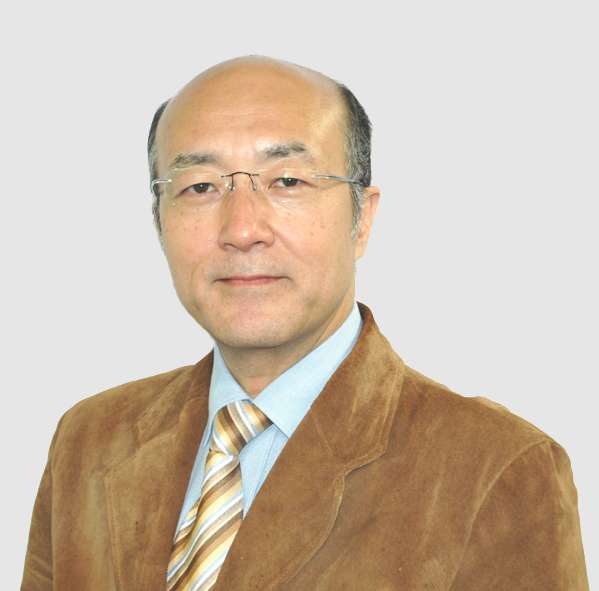
助手になった時と現在の科学技術を比べた時、映画のように突然変化したわけではないので必要以上の驚きは無いにしても、当時には無かったスマホ、ハイブリッドカー、インターネット等々は、おそらく1986年に桑畑助手が見ることがあれば、ビックリしたことであろう。光に関するテクノロジーズの30年間の進歩は目を見張るものがあり、光ケーブル、液晶テレビ、デジタルビデオ、デジタルカメラ、青色レーザー、青色LEDと、30年前には存在してなかったものが無数にある。「21世紀は光の世紀」という言葉は、1970年代に作られた標語であり、私も助手になった時にはすでに聞いていた。光を用いた研究をしていた桑畑助手は、この標語に全面的に賛同して予算申請書などに多用した。しかし、その具体性についてはぼやけていたが、上記の光デバイスが身の回りにある現在、まさに標語通りになったと感じている。光ケーブルやCCD等、目に見えない所にある光デバイスは知る者こそ知る存在で、そういう人でないと前出の標語の世紀の到来はわからないであろう。
さて、これからの30年はどうなっていくのであろうか?もっと目に見える「光の世紀」の時代となるのか?30年後は、私自身はこの世にいるかどうか分からないが、光の世紀のさらなる進化をこの目で見ていきたいと考えている。
2016年2月15日 桑畑 進 教授 大阪大学工学研究科 応用科学専攻 |
New Year's greetings / 新年のあいさつ
|
Happy New Year!
This year heralds the 10th year for the Photonics Advanced Research Center, a critical juncture for our organization. During this time we have striven to be an organization that creates industrial innovation in photonics while exploring new forms of industry-university collaboration and while engaging in many challenging initiatives. Our aggressive stance toward interdisciplinary integration is already churning out results in the form of commercialized devices and photonics venture companies. We believe our next step is to grow the Photonics Center into a global photonics center to which leading photonics companies will converge and to which we will attract the world’s brightest researchers and engineers.
The Photonics Center has also developed a platform for talent development through the promotion of international joint research programs with Asian research institutes in which graduate students and young researchers frequently visit from/to Japan. Our next desire is to form a research network between the world’s photonics research institutes and to deploy a global “brain circulation-type” talent development program as we pave the way on the photonics platform in a new academic area on a global scale.
also approached for our annual Photonics Day, which will be held on Wednesday afternoon, January 27. The slogan for this year is “Osaka University changes the world with light!” Dr. Eiichi Maruyama, an Advisory Committee member, will deliver the keynote, “Japan’s Science and Technology,” which will be followed by presentations on the Photonics Center’s past initiatives for innovation creation and future Center initiatives. We look forward to an active and enthusiastic discussion with all of you on the future of the Photonics Center.
We wish you all the best and look forward to serving in the new year. January 5th, 2016 Yasushi Inouye, Executive Director of Photonics Center, Osaka University |

今年は、フォトニクス先端融合研究拠点として、フォトニクスセンターが活動を開始して10年目という節目の年となります。産学連携の新たな形態を模索しながら、数々の取り組みに挑戦し、フォトニクス関連の産業イノベーションを生み出す組織づくりを推進してきました。異分野融合による研究開発を積極的に進めてきたことで、すでに製品化された機器やフォトニクスベンチャーの起業など成果が次々と出てきています。次は、フォトニクスセンターをさらに発展させ、フォトニクスの先端企業が集積し、世界から優秀な研究者や技術者を呼び込める世界的な拠点づくりを目指していきたいと考えています。
また、フォトニクスセンターでは、大学院生や若手研究者らがアジアを中心とした海外の研究機関との間で頻繁に行き交うなど国際的な共同研究を推進しながら人材育成を行う基盤も整備してきました。次は、世界中のフォトニクス関連の研究機関との間で研究ネットワークを形成し、フォトニクスを基盤とした新たな学術領域を世界規模で開拓しながら、頭脳循環型のグローバル人材育成への展開を行っていきたいと考えています。 さて、毎年恒例のフォトニクス・デイを1月27日(水)午後に開催いたします。今年のキャチフレーズは「阪大が光で世界を変える!」です。諮問委員のお一人である丸山瑛一先生に「日本の科学と技術」と題した基調講演をいただいた上で、これまでのフォトニクスセンターにおけるイノベーション創出活動やこれからの取り組みについて紹介するとともに、フォトニクスセンターの未来を皆様方とともに喧々諤々議論していきたいと思います。
本年も、何卒、よろしくお願い申し上げます。
2016年1月5日 フォトニクスセンター長 井上康志
|
Asian CORE Student Meeting 2015
|
I am Natsuo Taguchi, the president of OSA/SPIE Osaka University Student Chapter in this year. We, Student Chapter annually hold an international student conference which is planned and organized by students. For the past few years, we have invited many foreign students studying optics and photonics focusing from Asian countries and set up many opportunities to create international networks among the students. Since different countries have different culture and histories, and people living there have very different thoughts, we have realized how fresh and interesting it is to have discussions on the bases of a common keyword “Light”, with students from diversified backgrounds.
For this year, International Year of Light 2015, we, Student Chapter are honored to hold an international student meeting “Asian CORE Student Meeting 2015” during December 8-9. We will invite around 50 students from China, India, Japan, Malaysia, Taiwan, and Singapore to create valuable students’ networks. With a concept “how we should develop our careers in the future”, we will have fulfilling discussions through invited lecturers, panel discussions and group works etc. It is always one of the significant interests for students to get competent jobs by optimizing their own personalities. Moreover, career environments have been getting more international especially in Asia, and Japan is not the exception. In such diversified and international environments, we are sure that it will be very meaning opportunity for students to exchange their opinions regarding careers. We will also have two invited lecturers, Prof. Toyohiko Yatagai, Utsunomiya University and President of SPIE; and Prof. Satoshi Kawata, Osaka University and my supervisor. Because of their diverse experience and thoughts, we expect all attendees to be inspired for their future careers from their talks. We also plan to have oral and poster presentations for their research introduction.
Actually, Asian CORE Student Meeting 2015 is smaller in the budget, the number of attendees, and the number of days than the past conferences we had. However, we have been working so hard for the preparation for more than a half year so that we hope all attendees will be able to obtain satisfying results. Now the preparation of this meeting has come to the final stage. I would like to thank all the chapter staff and PARC staff for helping me to arrange this meeting, and Prof. Yatagai and Prof. Kawata for their warm supports and cooperation.
We will continuously do our best for the success of this conference.
Natsuo Taguchi, the president of OSA/SPIE Student Chapter, Osaka University
|

国際光年である今年も本チャプターは機会に恵まれ、国際学生会議 “Asian CORE Student Meeting 2015” を、12月8日と9日の2日間にかけて開催します。インド・シンガポール・台湾・中国・日本・マレーシアから約50人の学生を招待し、価値ある学生ネットワークの構築を目指します。今年は「キャリアをどのように今後の将来で築くべきか」というコンセプトのもとで、招待講演・パネルディスカッション・グループワークなどを通じて密度が濃い議論を行います。各々の個性を活かし満足のいく仕事に就くことは、どの時代およびどの国の学生おいても重要な関心事です。そして、今日のアジアにおけるキャリアの環境は年々国際化が進んでおり、日本もその例外ではありません。そのような環境の中で、キャリアに関する意見を様々な国の学生の間で交換することは、非常に有意義なものになると思っています。また、宇都宮大学の教授であり SPIE 現会長の谷田貝豊彦先生および私の指導教員である河田聡先生を、招待講演者としてお呼びしています。お二方が歩んでこられた幅広いご経験や考え方から、今後のキャリアへのヒントを参加者が得ることを期待しています。勿論、参加者による研究紹介も、口頭およびポスターの両方で行われます。
今回の学生会議は前年度と比べて、予算・参加人数・日数ともに小規模なものです。しかしその分、参加者全員がより多くのものを得ることができるよう、半年以上かけて準備してきました。その Asian CORE Student Meeting 2015 の準備も、いよいよ大詰めを迎えています。最後に、本学生会議の準備をサポートして下さった OSA/SPIE 大阪大学学生チャプターの皆さんおよび PARC 職員の方々、参加者の皆様、想像を超えるほどに多忙な中を縫って出席して下さる谷田貝先生、そして谷田貝先生を招待講演者として打診した瞬間に電話で直接依頼して下さった河田先生に、厚く御礼を申し上げます。本学生会議が参加者全員にとって最善なものとなるよう、尽力して参ります。どうぞよろしくお願い致します。
大阪大学 OSA/SPIE 学生チャプター代表 田口 夏生 |
Impressions on Life in the US – Dive into a Pro-Innovation Environment! /「米国生活で感じたこと」~イノベーションできる環境へ飛び込もう~
|
What I write here will deviate from the usual Photonics-related topics that have been addressed by my esteemed colleagues. With permission and with the hope that it will be beneficial especially to students, I have gathered my impressions below on life in the US and the differences with Japan.
I have lived in the US on two different occasions for a total of 10 years on both the East and West Coasts. My first occasion was as a Visiting Scholar at Columbia University for one year beginning in the October immediately following 9/11. The second occasion was when I was assigned to manage Sharp Labs of America (http://www.sharplabs.com) in Washington State for nine years. In my first US stint, I was on my own and faced many challenges in arranging everything and getting established by myself, and by the time of my second stint in the US I had a growing family, which made things very enjoyable but also presented other challenges. Although I would be happy to relate my family-related adventures, here I would like to focus on the attitudes in the US toward research and development as well as present my take on why interesting technologies and business models originate in the US.
The one year at Columbia University was short but very sweet. Although I did have to share equipment with other researchers, I was able to spend as many hours of the day as I liked, from morning to evening, on experimentation. Although I was on a limited one-year program and therefore was not taking any classes, other international students who were studying toward a postgraduate degree had to take classes. Foreign students faced the difficult challenge of English tests, which they had to pass to earn their degree, no matter what outstanding research and development they were working on. I remember the sight of students studying desperately despite having a much better command of spoken English than I did. A Korean, with whom I became friends as we discussed experimental results, had quit his job, immigrated to the US with his family, and paid high tuition fees and lived off his savings as he pursued his postgraduate degree. It is no wonder such students study for their dear lives! Another strong impression I received was that, despite all the international students from many different countries in all the labs, there were almost none from Japan. This was especially true of the school and research program (that I had enrolled in) covering mathematics, physics, and devices that had a high number of foreign students from Asia. After my time was up, I took the results of my research at Columbia back with me to Japan, basing the design and study of prototypes for a manufacturing device on those results.
Eventually the time came for my second stay in America. My initial assignment in North America was to investigate new device technologies and their supporting process technologies and bring them back to Japan. After some unanticipated developments, I ended up becoming the manager of Sharp Labs of America. Of the roughly 170 employees at Sharp Labs, a Sharp subsidiary, only six or seven employees were on assignment from Japan with the rest being locally hired researchers and engineers. The people at Sharp Labs, though hired locally, included not only US nationals, but naturalized US nationals, Dutch, English, Chinese, Korean, Japanese, Indian, Turkish, Italian, French and other nationalities. Even though there were a variety of cultures and backgrounds, they were a powerful driving force when they all meshed together. The hiring policy was to hire only experienced professionals; fresh graduates were not on the radar. Of course there were exceptions; an exceptional student deemed necessary for a project at Sharp Labs would be hired even if they had just come out of school. The hiring process includes resume screening, an interview with HR, and evaluations by multiple interviewers of the candidate’s technical background, presentation skills, and communication skills. I, too, had the valuable opportunity to conduct interviews. It was at this time that I realized the significance of having a postgraduate degree as well as an inkling as to one reason why I saw so few international students from Japan at Columbia University. Although it is a fact that American society is a meritocracy, it is a hierarchical society even more so than in Japan. There is a large gap in lifetime earnings between those with a postgraduate degree and those who are not. Unfortunately in Japan, having a Master’s degree or PhD does not result in a sizable difference in lifetime earnings (with the exception of some people), although having a higher degree may win admiration. Although this may be a biased view, I feel that this is one factor in why there is such a small number of Japanese students in US universities. At the same time, having a postgraduate degree does not necessarily guarantee smooth sailing; it does not guarantee being hired and may even lead to being laid off. True story: Sharp Labs once received an employment application from an assistant professor but we rejected him.
Let us move on to another topic. New products, concepts, and business models seemingly all originate from the US. Apple has built a superb ecosystem and business model for its iPhone, which now has many users in Japan as well. Some people say that, as a piece of hardware, not only is the iPhone inferior to Japan-made or Korean (Samsung)-made smartphones, but that almost all of its parts are made in Japan, Korea, or China. Such people say Apple succeeded only because they excelled at building the business model. However, their uncompromising obsession with design and the finished product, as well as the finish on the hardware, deserves a begrudging tip of the hat. Apple is famously known as having started as an idea in a garage, but I believe the pro-innovation environment was a significant enabler. Even today, the Bay Area where Apple grew up remains rife with entrepreneurs as well as venture capitalists and angel investors. Now there are venues for entrepreneurs to network, an example of which is Plug and Play Tech Center (http://plugandplaytechcenter.com/), a platform already being leveraged by Japanese companies and universities. This platform is very open and is producing interesting ideas every day, as well as small companies based on those ideas. The public has even embraced The Apprentice, a TV program that was hosted by presidential hopeful Donald Trump in which he evaluated and invested in people with interesting ideas. Such opportunities are constantly evolving. Another evolution is crowdfunding, a mechanism still in its infancy in Japan, which raises 10 times, sometimes even 100 times, the amount of funding in the US compared with Japan. Another positive aspect of US society is that there are many figurative dangling ropes for climbing out of the proverbial hole for people who have made a mistake but who just have that indomitable spirit. As mentioned above, people with higher degrees may become unemployed, but there are also many opportunities for a new job and new employment. The barriers to changing jobs seem low. If a job calls for a higher degree, there are many open doors to earn that degree. One’s social status (housewife or working professional), race, and age, has no bearing on their enrollment in US universities as students of all walks of life study to attain their goals. There may of course be several such students in Japanese universities, but they are likely few in number. Many companies no longer have pension plans which make it easier for workers to change jobs and companies to hire experienced professionals. Other factors for the low barriers in changing employment are that age and gender basically are not an issue and that information on income levels for occupation, region, and skills are essentially commonly known.
I may have painted a rosy picture of the US, but keep in mind there are negatives as well and aspects in which Japan is superior in a systematic way. What I can say is this: there is no substitute for experiencing the US on a first-hand basis. Even if it is for one week (but not on a guided tour), you will be able to get a taste of the openness of that country. If you have the confidence and the desire to test yourself, then I definitely recommend earning a degree at a US institution. If you are not interested in going overseas, at the minimum I recommend that you study English, which is absolutely necessary if you are to be competitive with your global peers.
Junichiro Nakayama
Vice President of Corporate R&D Division Head of Advanced Technology Research Laboratories SHARP Corporation |
これまで先生方や諸兄の方々が書かれたような、フォトニクスに関わるトピックスとは少し異なることであることをお許しいただき、特に学生の皆さんの何かの参考になればとの思いで、米国生活で感じたこと、日本との違いなどについて、少し書いていきます。
これまでに、米国には2度住んでいます。1回目は、ナインイレブン直後の10月から1年間、コロンビア大学に研究員-Visiting Staffとして、2回目は、ワシントン州にあるシャープアメリカン研究所(http://www.sharplabs.com/)をマネージする立場で約9年間赴任しましたので、合計で10年、東海岸と西海岸の生活を経験しました。1回目の赴任では、生活の立ち上げをすべて一人でしただけに苦労をしましたし、2回目の赴任中には、家族が増えたこともあって、楽しいことだけではなく、色々と大変なこともありました。プライベートの話は、お会いさせていただいたときにでもゆっくりさせていただくこととし、ここでは、研究・開発に対する姿勢や、どうして面白い技術やビジネスモデルは、米国から生み出されるのかに関して、自分なりの解釈も加えて記します。
コロンビア大学での1年間は短かったですが、非常に充実したものでした。他の研究生と装置のシェアは必要ですが、朝から晩まで好きなだけ、実験検討ができました。私自身は1年と期間限定であり、授業を取らなかったのですが、学位を取りに留学している学生たちは授業もあります。海外の学生にとって難しいのは英語の試験であり、これに通らないとたとえ優れた研究開発をしていても学位はもらえません。私なんかよりもはるかに英語のしゃべれる人でも、必死になって勉強していた姿が思い出されます。一緒に実験結果をディスカッションするなかで仲の良くなった韓国人友人は、一旦会社を辞めて、家族と一緒に米国に移り住んで、高い授業料と高い生活費を貯金で賄いながら、学位を取ろうとしていましたので、必死になるのも頷けます。
もう一つ印象に残ったのは、各研究室とも、様々な国からの留学生がおり、特に私が居た研究室、学部は、数学、物理、デバイスに関わるところでしたので、アジアからの学生が非常に多かったのですが、日本人の学生はほとんど見かけませんでした。で、コロンビア大学での成果を一旦、日本に持ち帰り、その結果をベースに生産装置のプロトタイプの設計や検討をしました。


別の話をしましょう。新しい商品、コンセプト、ビジネスモデルはほとんどが米国発です。Apple社のiPhoneは、そのエコシステムの構築からビジネスモデルまで非常に素晴らしいものであり、日本でも多くのユーザーが居ます。iPhoneをハードウェアとして考えると、日本あるいは韓国のSmartphoneの方が優れているし、そもそもパーツのほとんどは、日本製、韓国製、中国製なので、彼らはビジネスモデルとしてうまく構築しただけだという人もいるかと思います。しかしながら」、そのデザインや最終製品に見る製品に対するこだわりに妥協はなく、ハードウエアとしてもトータルでの仕上がりでも残念ながら脱帽せざるを得ません。もともとは、アイデア勝負でガレージから出発したことは周知のことですが、それを生み出せる環境があったということが大きいと思います。Apple社が育ったBay Areaには今でも沢山の起業家があり、それを支えるベンチャーキャピタルやエンジェルと呼ばれる投資家たちがおり、さらに彼らの出会いを提供する場もあります。一例として、既に日本の企業や大学も利用しているPlug and Play Tech Center (http://plugandplaytechcenter.com/)を紹介しますが、非常にOpenで日々面白いアイデアとそれに基づく小さな会社が生み出されています。これだけにとどまらず、大統領選に出馬しようとしているトランプ氏が審査員を務め、面白いアイデアには出資するテレビ番組(The Apprentice)さえあります。これらの仕組みも日々更新されている状況です。また、日本でも最近使われるようになってきたクラウドファンディングですが、米国では日本の10倍、時には100倍もの資金が集まります。
さらに、米国社会で良いと感じるのは、失敗した人でもチャレンジ精神のある人への救済が色々とあることです。前記の学位があっても解雇される話にもつながりますが、解雇されても再就職、再雇用の機会は数多あり、転職に対する壁の低さを感じます。学位が必要な職業であれば、学位を取れる門戸は広く開いています。米国の大学では、主婦も社会人も人種も年齢も全く関係なく入学し、それぞれの目標に向かって勉学します。もちろん、日本の大学にもそういう人が居ますが、少数だと思います。多くの企業が退職金という制度を持っていないことは、転職、キャリア採用を容易にしていますし、さらに年齢や性別が原則不問であること、職業、地域、スキルによりにどの程度の給与であるかという情報がほぼほぼ共有されていることも大きいと思います。
米国の良いところばかりを書いてきましたが、もちろん、悪いところもあり、日本の方がシステムとして優れていることもあります。一つ言えることは、自分の目で見て感じていただくのが一番だと思います。たとえ一週間の(ただし、ツアー付のパッケージ旅行ではない)観光旅行でも、少しは感じられると思いますし、自信があって、自分の実力を試す勇気があるなら、米国の大学で学位を取られることを是非お勧めします。そして、もし米国へ行くことに興味がなくても、グローバルな世界で勝負するためには、少なくとも英語の勉強だけは欠かすべきではありません。 シャープ株式会社 研究開発本部 先端技術研究所所長 |

